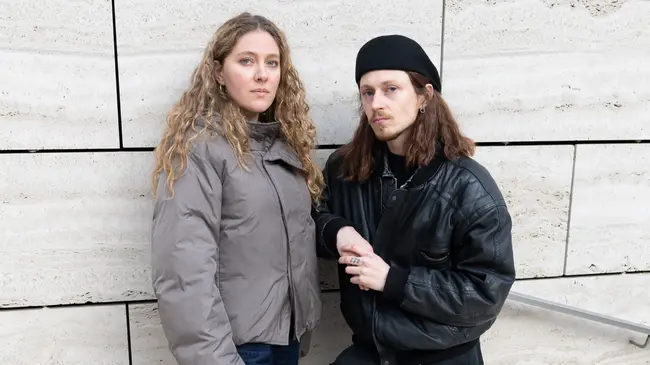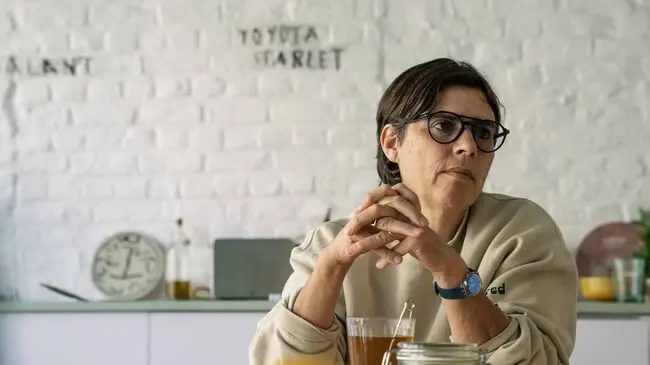Putting an artwork in a museum is a complex thing

Until the third of October, you can go view the work of the three laureates of the Friends of S.M.A.K Prize over at S.M.A.K. The competition is a celebration of a new generation of artists and a stepping stone in their young careers. A jury selected them out of 112 portfolio submissions, and they all have their own defined artistic universe. Come meet Jimena Chávez Delion, Mark Grootes, and Angyvir Padilla.
The Friends of S.M.A.K. Prize 2020-2021 will be awarded on Sunday 3 October 2021. This also includes a Public Prize. Cast your vote for the artist you think deserves the award. Vote until midnight on 2 October 2021.
Mark Grootes

What’s your work The Planthunter about?
The Planthunter is both a sculpture and the main character in my movie Wild Wildenburg. I made them for the Waldeinsamkeit residency programme, curated by Koi Persyn, which happened during the summer of 2020.
This residency happened at the private aristocratic domain of Wilderburg in Wingene, West-Flanders. I used this specific place to talk about the plant hunters, explorers from past centuries that went to other continents searching for rare and unknown species of plants to bring back to the gardens of Europe’s aristocracy.
The Planthunter itself is a sculpture and monument for the plant hunters, built upon a garden cart with which I was able to explore Wildenburg, searching for plants that were brought into Europe by the Planthunters. It has the shape of a tree, with a rhododendron planted on top of it, and attached to the tree trunk of the Planthunter are a set of plant-hunting tools. The movie Wild Wildenburg documented this quest, using the style of BBC nature documentaries.
In S.M.A.K I made an installation with additional sculptures and drawings. Putting an artwork in a museum is a complex thing. I made use of the aesthetics used in natural history museums to have a better frame to talk about these subjects within a museum context.
I am trying to find an approach to talk and think about the colonial past
What kind of reaction would you like to evoke with your audience?
I hope I have given the audience a narrative that is comforting and familiar, while also using humour and a bit of parody to add extra layers of meaning between the sentences. In a way, I am trying to find an approach to talk and think about the colonial past of ‘western’ Europe and how we are now in a time and age where we have to deal with ourselves within this subject.


Who would you want to collaborate with, and why?
I think I can also translate this question into who I think is a great artist. The answer is Mika Rottenberg.
Mika Rottenberg is an Argentine/Israeli video and installation artist, currently living in New York. I first encountered her work at the Venice Biënnale of 2015 and again in 2016. I also saw her retrospective at Palais de Tokyo in Paris. Both encounters were breathtaking moments for me. I frequently walk through art shows almost more focused on finding ideas or techniques that one day can be useful for my works instead of experiencing the art. That wasn’t the case with Mika Rottenberg’s show. I was completely lost in her eccentric worlds, in which female bodies or body parts were constantly placed or portrayed as production mechanisms in almost dreamlike absurdism. One of the elements I find very beautiful in her work is that the environments in the movies also come out of the screen into the museum space within the installations. Her balance between these two, I think, creates incredible shows. Mika, if you want to collaborate, I will travel to the edge of the world for it.
Jimena Chávez Delion
The feeling of distance and yearning is funnily entangled with corporate, impersonal objects

Where do your inspirations come from?
My idea for the show at S.M.A.K came from my experience of living in Belgium. The starting point was a piece I did in 2019, a 2-channel video that I recorded in Antwerp and Brussels. In these videos, you see specific social interactions within transactional activities, in street markets and money exchange shops - body movement and its patterns, diverse codified gesturing, language, and interpersonal relationships. My attention focuses on the different layers of exchange that seem to be shaping idiosyncratic forms of communication. It's as if they were creating transient bridges which go beyond hegemonic languages imposed as a way of citizenship.
For the rest of the pieces, I reflected on body displacements in urban everyday life, particularly in Lima. The feeling of distance and yearning is funnily entangled with corporate, impersonal objects in banks, for instance. But this is also apparent in other less formal spaces like 'call shops' and cyber cafes, where interior design merges with precariousness, obsolescence, and affectivity.


In the video of friends of SMAK, you tell us you often get inspired by urban spaces. Were there any specific places that inspired you to make your work?
I’m inspired daily by both urban and private spaces. Mostly those found somewhere in between private and public spaces, for example, commercial ones, where people are constantly entering and exiting the premises, interacting, talking and moving between one another all the time.
The installation at S.M.A.K was, like I said, partly inspired by money transfer offices and the public areas around the markets in Brussels, Antwerp and Lima. To me, these spaces are scenarios of social and transcultural relationships. I also feel emotionally attached to them, as I grew up close to a market area. In banks, airports and corporate spaces people will follow a specific and non-personal protocol of behaviour, where the premises have been designed in a cold, minimalistic and aspirational way.
It’s interesting how people’s customs are exchanged within the public space, and how this relates to transactional activities and globalization. I think it is important to reflect upon how this is going to change in the future, where since COVID, our bodies need to behave in a particular schematized way and where distance is now an important part of our daily life.
I take things with me, both physically and in my memory
Using a broad range of materials, would you regard yourself more as a hunter or as a gatherer? Why?
I don’t see myself as a hunter, I would say I’m more of a gatherer. I inhabit the space in the same way all people do, and then see what happens within that space; what remains hidden in the everyday, what are the materials composing the space and how people - myself included - relate to them.
I usually choose materials that compose the spaces I’m working with, materials that are related to the design and architecture. Particularly materials that ‘mimic’ or resemble other ones. I’ve recently also been using ceramics for particular pieces that remind me of the act of exchange and physical human contact.
Furthermore, I tend to use objects that I find within urban spaces, mostly trash or vestiges of something. I take things with me, both physically and in my memory.
Angyvir Padilla
Combining similar materials or mediums, might create a whole new family of meaning

Your art universe includes many different media: soundscapes, video, photography, print… Where does your love of multimedia come from?
My installations combine a variety of materials and media such as plaster, wax, ceramics, photography, sound, video and performance. They are environments that bring into play notions of belonging and intimacy.
The range of materials and media I use is part of my creative process. The materials can evoke the transformation of matter and the memory of their different states (as with wax, clay, or plaster), or the passage and transformation of time (in the case of video and still images).
These materials and media reflect by themselves and by their potential: it’s a concern that is present in my work. They work as an alphabet from which I serve myself at the moment of creation, depending on the subject I am interested in at a given moment.
All my works, with their diverse materials and techniques, somehow function as a kind of constellation. Combining similar materials or mediums that are related in some way might create a whole new family of meaning.
These materials respond to each other and contribute to the creation of immersive environments, whether it is when I present sets of different artworks in an installation or when I conceive a single installation that embraces the entire space.


How do nature and spirituality influence your art?
I attempt to convey a feeling of nostalgia or melancholy without the need to understand what is being said
I am interested in exploring the gaps and intervals between identity, memory, materials, space, and how these may echo with different ways of interacting with intimate places or states of mind. I believe that the way I treat and present my pieces and materials with space offers many possibilities for incursions and emotional connections to the viewer, allowing me to rely on what the material and objects have to say without forcing them.
With the use of sound in my installations, I attempt to convey a feeling of nostalgia or melancholy without the need to understand what is being said. In general, I use songs or text in Spanish, so most of the spectators here in Belgium do not understand the lyrics, which makes them have to pay way more attention to the tone or the way it is sung in relation to the installation. The song I use is usually sung by myself, which makes them a bit naive in their interpretation, but it also makes the installation very personal, it’s sort of a ritual to wander around them. The popular Venezuelan songs I have chosen for some of my works carry with them a sentiment of found and/or lost 'home'. They refer to the human experience and life through nature: addressing the moon, the plains, landscapes, and can sometimes recall a collective and prevalent feeling of ‘missing home’ by the memory of a ‘cherished landscape’ or by ‘missing a lover’ for example.
Over the years my artistic practice has developed in a constant effort to find my confidential place in and through art
What is a theme or inspiration that keeps returning in your practice?
The departure from my home country Venezuela in 2011is very important within my artistic practice. Since I moved to Belgium, the sense of losing what was familiar or ‘home’ to me stuck with me. I wondered: what is ‘home’? To lose this place, to seek for it, notions of distance and proximity, etc. The increasingly complex political situation in Venezuela contributes to this sentiment. I often work on diaspora, the spread of identities, and how feelings of homesickness not only impact immigrants. Our current globalized way of life can also result in a collective sense of feeling "out of place" because of the speed at which we live, because of the little time we have to connect with others and with ourselves, or because of how distanced we are from nature. Over the years my artistic practice has developed in a constant effort to find my confidential place in and through art.
Different Class works with the interest of their community at heart.
Our work’s purpose is to foster a solid network for independent artists, those who love them, and those who want to support them. Become a member to contribute to the local Belgian art scene.





